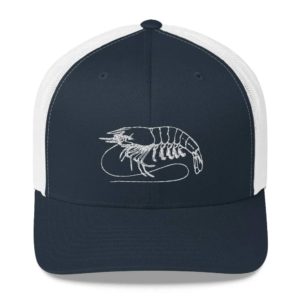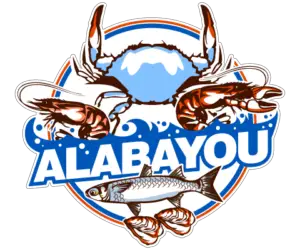Shrimp are a quick and easy meal, making them an excellent option for a weeknight dinner or when you need to prepare something quickly for your guests.
While there are many ways to prepare shrimp, boiled shrimp has become a staple meal among many American communities.
Here are 6 easy steps to boil peeled shrimp:
- Rinse in cold water and let set at room temperature
- Fill the cooking pot with enough water to submerge all shrimp
- Boil water before adding shrimp
- Add shrimp to boiling water for 1-2 minutes
- Remove from heat, cover, and let sit for 5-10 more minutes
- Drain and serve warm
Shrimp is sold fresh or frozen. If you like to buy fresh shrimp, you must peel and devein the shrimp yourself. You can buy pre-peeled frozen shrimp if you want to avoid the peeling and deveining process.
Keep reading because you don’t want to miss the intricacies of how to boil peeled shrimp!
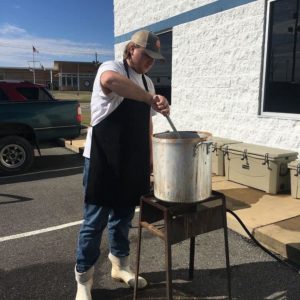
How to Peel Shrimp
You can peel shrimp before or after you boil it. The process is similar in both situations, except you must let boiled shrimp cool down before peeling it.
This article assumes your shrimp is already peeled, but…growing up in Bayou La Batre, Alabama, I’ve learned that many people need a little help properly peeling their shrimp.
Follow the steps below to peel your shrimp before or after boiling it:
- Grab the shrimp head and pop it off.
- Slide your thumb under the shell and use your other hand to pull off the whole shell.
- Remove the tail unless you are preparing a handheld appetizer like coconut shrimp.
- Devein your shrimp using a paring knife to make a shallow cut on the shrimp’s back and pull out the vein with your fingers.
You can use the shrimp shells to make shrimp stock, so do not throw them away. Deveining the shrimp is not necessary, but most people do it. The shrimp vein is its gut, and there is no health risk associated with eating it.
Some people prefer boiling shrimp in the shell and peeling it after cooking because the shells help preserve the flavor of this delicate seafood.
To make peeling boiled shrimp easier, I suggest not adding any seasoning or salt to the water as it boils. The spices might get between the shells making the peeling process difficult.
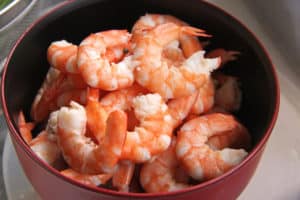
How to Boil Your Peeled Shrimp
You will need the following ingredients for peeled, boiled shrimp:
- Shrimp (1-3 pounds of shrimp per person)
- Freshwater
- Salt
- Pepper
- Olive oil
Method
Rinse your peeled shrimp in cold water and let it sit at room temperature for a few minutes.
If you are using frozen shrimp, it is best to let it thaw in the refrigerator overnight and remove it for 20 minutes before cooking.
Fill up your cooking pot with enough fresh water so the shrimp is submerged when cooking.

Heat your stove and let the water boil until you see bubbles. Add your peeled shrimp to the boiling water then bring water back to a rolling boil and let it boil for 1-2 minutes.
Around the 2-minute mark, switch off the heat and add your seasoning. Let the shrimp soak in the pot for 5-10 minutes.
*Pro-Tip: The shrimp is cooked once it turns opaque and pink.
Use a strainer or colander to drain the shrimp and serve when warm. You can put the shrimp in cold water to end the cooking before serving.
What to Serve with Boiled Shrimp
There are several sides you can serve with your boiled shrimp Some of the best options include:
- Boiled corn,
- Boiled new red potatoes
- Rope sausge
*Pro Tip: Boil your corn and potatoes in a separate pot to prevent them from absorbing all the seasoning away from the shrimp
A Shrimp boil is a favorite among certain communities because it contains tender shrimp and all the delicious sides in one pot.
The classic southern shrimp boil will have shrimp, sausage, corn, and potatoes in one pot, creating a hearty, flavorful meal for the family. Check out our complete guide on how to boil shrimp
What is the Best Shrimp to Boil?
With seafood, fresh is always best, but frozen shrimp can be (almost) as good when done right. Some people argue that there is no difference between the two because fresh shrimp undergo a preservation process before it gets to the market.
Shrimp are delicate- the longer they stay out of the water without proper care, the higher the risk of losing their taste and texture.
I recommend wild-caught American shrimp to enjoy the best shrimp boil. If you want to explore more options, here are my picks for best-tasting shrimp caught right here in the USA.
There are over 300 species of shrimp, and each differs in size, taste, and cooking time. The size of the shrimp depends on the meal you want to serve your guests.
Most people go with large shrimp because the fish shrinks once cooked. You can choose from 16-20 or 26-30 count size shrimp, depending on what is available in your area.
How to Choose the Best Shrimp
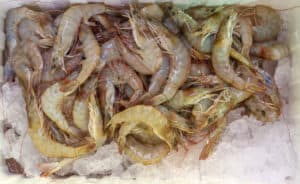
While fresh seafood is always considered the best option, fresh shrimp can be difficult to find. Many people opt for frozen shrimp because the quality is almost the same as fresh shrimp.
*Pro-Tip: If you do buy frozen shrimp, I recommend wild caught shrimp caught in the U.S.
Peeled and deveined frozen shrimp have less flavor than unpeeled ones because they are cleaned before freezing. After thawing your frozen shrimp, ensure the shells do not have any dark spots or melanosis (a sign that the shrimp is decaying).
Shrimp with yellow shells with a gritty feel indicate the use of bleach to remove the dark spots making the fish unhealthy. Your thawed shrimp should smell like salt water and have firm meat that fills the shells.
Educating yourself on the type of shrimp available in your local fish market is crucial, so you know what to look for.
Color is the first thing affected when shrimp starts to go bad. The next thing is the smell. Bad shrimp will have a strong ammonia smell, while fresh shrimp will have a seaweed-like smell.
The Best place to Buy Shrimp.
The best place to buy shrimp is at the fish market or right off the boat! Oh, and you can get all of your shrimp swag right here on my site!
